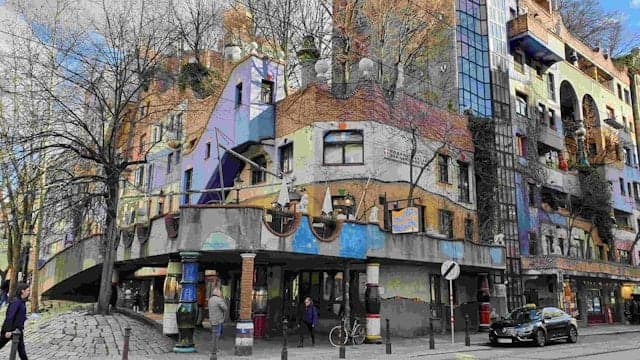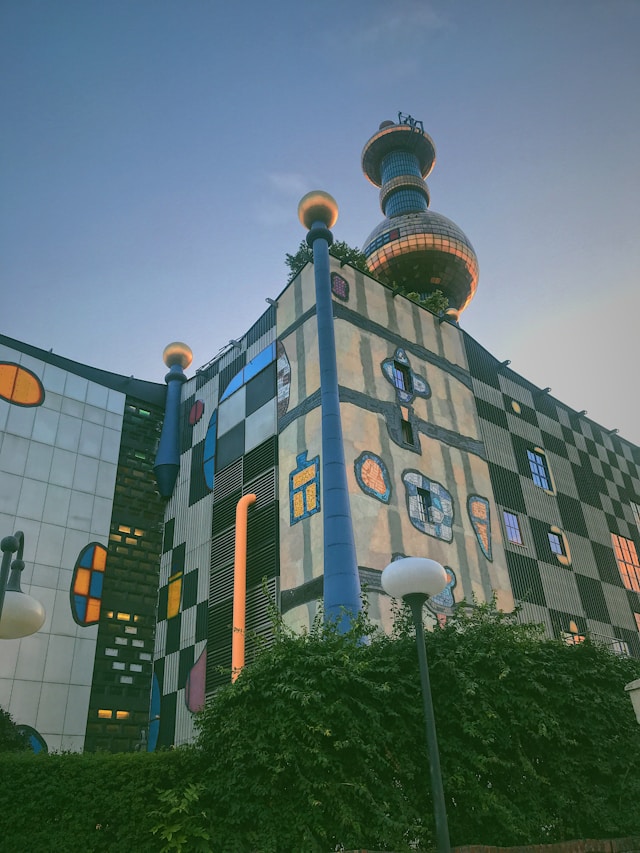Hundertwasser: Who is Austria's 'quirky' architect and where is his work?

Friedensreich Hundertwasser is one of Austria's most influential artists and architects. His artwork can be found in various locations all over the country.
Friedensreich Hundertwasser was born in Vienna in 1928, and his artistic contributions have made a significant and lasting impact on Austria.
His unique style is easily recognisable. Lively colours, playfulness, irregular shapes and connections to nature characterise it.
Hundertwasser's artistic and architectural creations were influenced by his philosophical beliefs, rejecting the limitations of conventional society and standardised urban design. Instead, he wanted to express the human connection to nature and creativity through his work. He considered that humans should live in harmony with nature, and his art often presents themes related to environmentalism and humanism.
Hundertwasser avoided straight lines and worked with curves and spirals. His architectural designs often include uneven floors and dense vegetation integrated into the structure of the buildings.
In Austria, you can find Hundertwasser's work in several locations, primarily focusing on his architectural designs. Here are some examples of his work and where to find it.
Hundertwasserhaus
Hundertwasserhaus is located in Landstraße, the third district of Vienna. It is one of his most famous architectural creations.
The apartment building is part of Vienna's social housing program, holds 52 individual apartments and was designed to provide affordable housing to city residents.
The building is well known for its lively colours, playful shapes, and integration of vegetation into its structure, with more than 200 trees and plants placed on the balconies and roof terraces.
As a visitor, you can only view the building from the outside. However, on the opposite side of the building, you will find Hundertwasser Village, which includes a shopping centre created by Hundertwasser, with a bar and some souvenir shops in typical Hundertwasser style.
Kunst Haus Wien
Kunst Haus Wien is a museum located on Landstraße, in Vienna's third district, just a few streets away from Hundertwasserhaus. The building is famous for its colourful façade, playful shapes, uneven floors, and integration of vegetation.
The museum holds a collection of Hundertwasser's artworks, with paintings, prints, and architectural models. As a visitor, you can explore Hundertwasser's work, which often deals with themes such as nature, ecology, and humanism.
A ticket to the museum's exhibitions costs around €15.

Dmytro Shchetynin. Spittelau waste plant.
Spittelau waste plant
The Spittelau waste plant is located in Alsergrund, the ninth district of Vienna. It is not only famous for its efforts to make waste management more sustainable but also for its captivating design.
In 1987, the original plant was damaged by a fire, leading the Viennese state to decide to rebuild it with an innovative design. They involved Hundertwasser in the project, who transformed the plant into a more visually pleasing and environmentally friendly construction with green roofs and playful vegetation.
Hundertwasser designed the plant with a colourful façade, irregular shapes, and integrated vegetation. His aim was to create a building that not only fulfilled its functional purpose but also served as a symbol of environmental awareness and sustainability.
Rogner Bad Blumau
Rogner Bad Blumau Thermal Spa is located in Bad Blumau in Styria. It is known for its unique architectural design realised by Hundertwasser.
Lively colours, organic shapes, and integration with the surrounding natural landscape characterise the spa resort. Hundertwasser aimed to create a space that celebrates the beauty of nature while offering visitors relaxation and healing.
The resort covers an extensive area and offers various indoor and outdoor thermal pools. The thermal pools are filled with mineral-rich water obtained from thermal springs in the area.
In addition to the thermal pools, the spa offers many other facilities, such as saunas, steam baths, massage treatments, and holistic therapies.
A full-day ticket to the spa costs around €60.
READ ALSO: The top 5 quirkiest buildings in Austria
Hundertwasser Church
Another famous example of Hundertwasser's architectural work is the Hundertwasser Church, also known as St. Barbara's Church, located in Bärnbach, Styria.
Hundertwasser designed the church in the 1980s and is famous for its playful design in the typical Hundertwasser spirit. Characterised by colourful mosaic tiles, playful shapes, and vegetation growing on its roof and walls, the church is considered one of Austria's most important examples of contemporary church architecture.

Hundertwasser Rastplatz. Julia Hjelm Jakobsson / The Local
Hunderwassert Rest Area
Located on the highway in Bad Fischau, just outside Wiener Neustadt, you can find a rest area with a building designed by Hundertwasser.
The building combines many elements of Hundertwasser's art, such as playful shapes, bright colours, and connections with nature in terms of vegetation integrated into the building.
The rest area is a famous spot where people take a break from driving while admiring Hundertwasser's art.
Since its creation in 1989, the building has hosted various fast-food restaurants.
Comments
See Also
Friedensreich Hundertwasser was born in Vienna in 1928, and his artistic contributions have made a significant and lasting impact on Austria.
His unique style is easily recognisable. Lively colours, playfulness, irregular shapes and connections to nature characterise it.
Hundertwasser's artistic and architectural creations were influenced by his philosophical beliefs, rejecting the limitations of conventional society and standardised urban design. Instead, he wanted to express the human connection to nature and creativity through his work. He considered that humans should live in harmony with nature, and his art often presents themes related to environmentalism and humanism.
Hundertwasser avoided straight lines and worked with curves and spirals. His architectural designs often include uneven floors and dense vegetation integrated into the structure of the buildings.
In Austria, you can find Hundertwasser's work in several locations, primarily focusing on his architectural designs. Here are some examples of his work and where to find it.
Hundertwasserhaus
Hundertwasserhaus is located in Landstraße, the third district of Vienna. It is one of his most famous architectural creations.
The apartment building is part of Vienna's social housing program, holds 52 individual apartments and was designed to provide affordable housing to city residents.
The building is well known for its lively colours, playful shapes, and integration of vegetation into its structure, with more than 200 trees and plants placed on the balconies and roof terraces.
As a visitor, you can only view the building from the outside. However, on the opposite side of the building, you will find Hundertwasser Village, which includes a shopping centre created by Hundertwasser, with a bar and some souvenir shops in typical Hundertwasser style.
Kunst Haus Wien
Kunst Haus Wien is a museum located on Landstraße, in Vienna's third district, just a few streets away from Hundertwasserhaus. The building is famous for its colourful façade, playful shapes, uneven floors, and integration of vegetation.
The museum holds a collection of Hundertwasser's artworks, with paintings, prints, and architectural models. As a visitor, you can explore Hundertwasser's work, which often deals with themes such as nature, ecology, and humanism.
A ticket to the museum's exhibitions costs around €15.

Dmytro Shchetynin. Spittelau waste plant.
Spittelau waste plant
The Spittelau waste plant is located in Alsergrund, the ninth district of Vienna. It is not only famous for its efforts to make waste management more sustainable but also for its captivating design.
In 1987, the original plant was damaged by a fire, leading the Viennese state to decide to rebuild it with an innovative design. They involved Hundertwasser in the project, who transformed the plant into a more visually pleasing and environmentally friendly construction with green roofs and playful vegetation.
Hundertwasser designed the plant with a colourful façade, irregular shapes, and integrated vegetation. His aim was to create a building that not only fulfilled its functional purpose but also served as a symbol of environmental awareness and sustainability.
Rogner Bad Blumau
Rogner Bad Blumau Thermal Spa is located in Bad Blumau in Styria. It is known for its unique architectural design realised by Hundertwasser.
Lively colours, organic shapes, and integration with the surrounding natural landscape characterise the spa resort. Hundertwasser aimed to create a space that celebrates the beauty of nature while offering visitors relaxation and healing.
The resort covers an extensive area and offers various indoor and outdoor thermal pools. The thermal pools are filled with mineral-rich water obtained from thermal springs in the area.
In addition to the thermal pools, the spa offers many other facilities, such as saunas, steam baths, massage treatments, and holistic therapies.
A full-day ticket to the spa costs around €60.
READ ALSO: The top 5 quirkiest buildings in Austria
Hundertwasser Church
Another famous example of Hundertwasser's architectural work is the Hundertwasser Church, also known as St. Barbara's Church, located in Bärnbach, Styria.
Hundertwasser designed the church in the 1980s and is famous for its playful design in the typical Hundertwasser spirit. Characterised by colourful mosaic tiles, playful shapes, and vegetation growing on its roof and walls, the church is considered one of Austria's most important examples of contemporary church architecture.

Hunderwassert Rest Area
Located on the highway in Bad Fischau, just outside Wiener Neustadt, you can find a rest area with a building designed by Hundertwasser.
The building combines many elements of Hundertwasser's art, such as playful shapes, bright colours, and connections with nature in terms of vegetation integrated into the building.
The rest area is a famous spot where people take a break from driving while admiring Hundertwasser's art.
Since its creation in 1989, the building has hosted various fast-food restaurants.
Join the conversation in our comments section below. Share your own views and experience and if you have a question or suggestion for our journalists then email us at [email protected].
Please keep comments civil, constructive and on topic – and make sure to read our terms of use before getting involved.
Please log in here to leave a comment.